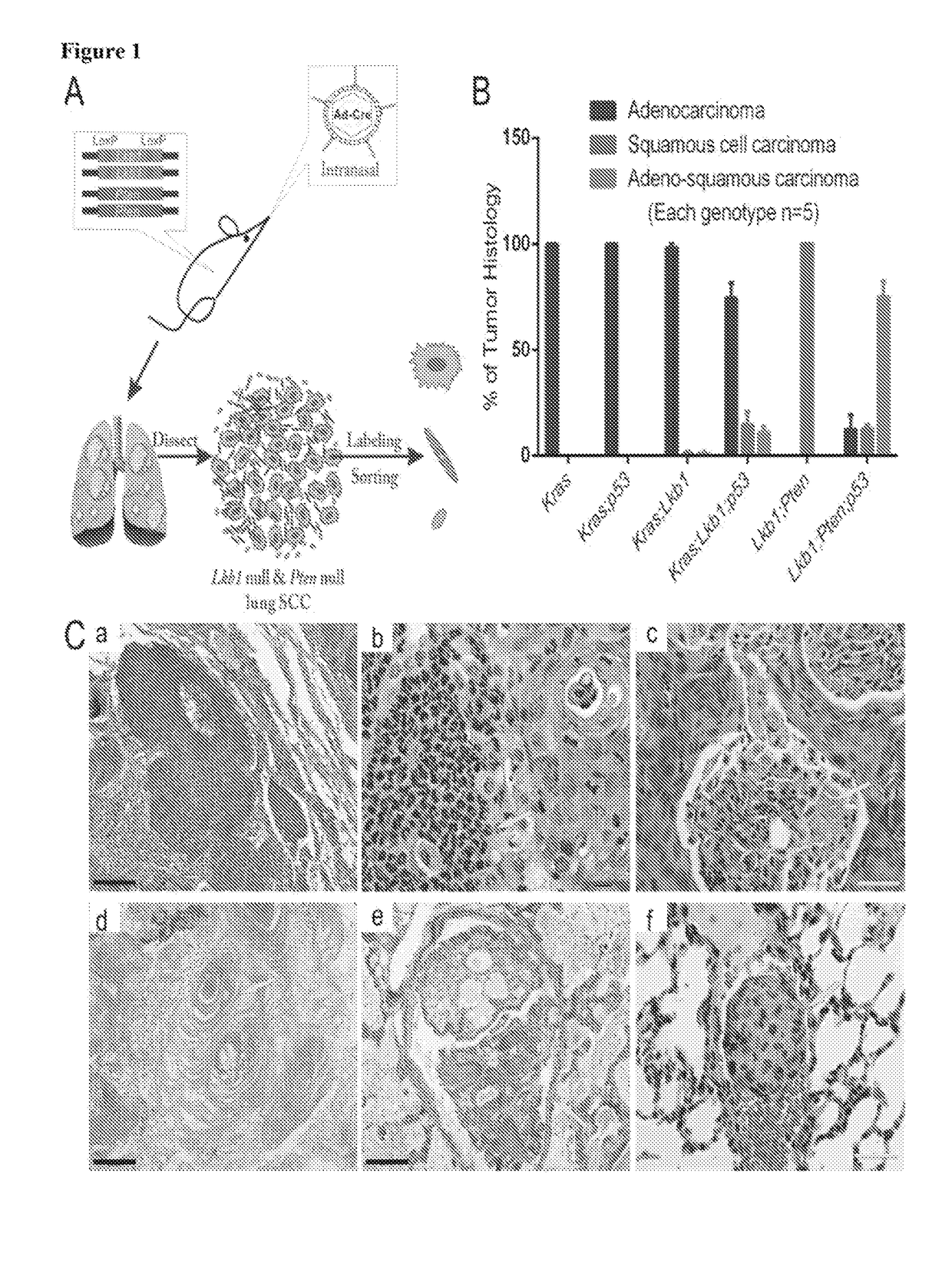Tumor suppressor and oncogene biomarkers predictive of Anti-immune checkpoint inhibitor response
a technology applied in the field of tumor suppressor and oncogene biomarkers predictive of anti-immune checkpoint inhibitor response, can solve the problems of tumors of purely squamous phenotype, field lack of mouse model, and no major rol
- Summary
- Abstract
- Description
- Claims
- Application Information
AI Technical Summary
Benefits of technology
Problems solved by technology
Method used
Image
Examples
example 1
and Methods for Examples 2-7
[0365]a. Mouse Cohorts and Human Samples
[0366]Mouse cohorts of Lkb1fl / fl;Ptenfl / fl, Lkb1fl / fl;Ptenfl / fl;p53; LSL:KrasG12D, LSL:KrasG12D;p53fl / fl, LSL:KrasG12D;Lkb1fl / fl, LSL:KrasG12D;Ptenfl / fl and LSL:KrasG12D;LKB1fl / fl;p53fl / fl were all maintained in virus-free conditions on a mixed 129 / FVB background. Nu / Nu mice were purchased from Charles River Laboratories International Inc. All the mice were housed in a BL2 lab at Dana Farber Cancer Institute. All care and treatment of experimental animals were in accordance with Harvard Medical School / Dana-Farber Cancer Institute institutional animal care and use committee (IACUC) guidelines. Mice were given Ad-Cre via intranasal infections at 6-8 weeks old. Mice were monitored for signs of lung tumor onset and euthanized for gross and histological analysis and tumor isolation upon signs of distress. Patient slides were provided by the pathology department of Brigham and Women's Hospital. All human samples and clini...
example 7
pagating Cells Express High Levels of PD-L1
[0412]Little is known about how tumor propagating cells escape immunologic clearance and clonally expand to form malignant tumor nodules. To address this question, the PD-L1 level on LP tumor cell fractions was further quantified. By gating the four SCA1;NGFR fractions and analyzing the percentage of PD-L1+ cells in each fraction, a clear enrichment for PD-L1+ cells was found within the SCA1+NGFR+ fraction (FIG. 13A). Within a group of 7 mice, an average of 69% of SCA1+NGFR+ cells expressed PD-L1 on their cell surface, while only 39% of SCA1+NGFR− or 32% of SCA1−NGFR+ cells were PD-L1+ (FIG. 13B; p=0.004). Likewise, by real-time RT PCR for Pdl1 within the sorted LP tumor fractions, SCA1+NGFR+ cells had 7-fold more Pdl1 mRNA than SCA1−NGFR− cells and about 2-fold more than SCA1+NGFR− or SCA1−NGFR+ cells (FIG. 13C; p=0.035). Flow cytometry and real time RT-PCR were also used to assess PD-L1 levels in BASCs and basal cells. NGFR+ BASCs express...
example 8
Inhibitors Modulate Immune Cell Populations and Function to Treat Cancer in a Variety of Tumor Models
[0414]As described above, arginase 1 expression is significantly increased in LP tumor cells. Similarly, arginase 1 expression is enriched in Kras G12D mutant mice, as opposed to EGFR mutant mice, as measured by both gene expression and immunohistochemical analyses (FIGS. 15-16). The Kras1, Kras2, and Kras3 images shown in FIG. 16 are from different tumors obtained from different Kras G12D mutant mice. In general, Kras mutant tumors (e.g., obtained from Kras G12D mutants. Kras G12D+Lkb1 mutants, and Kras G12D+p53+Lkb1 mutants) express arginase 1 at a higher level than EGFR mutant tumors. Pten, Lkb1, and p53 tumors also express high levels of arginase 1 (see, for example, Xu et al. (2014) Cancer Cell 25:590-604).
[0415]Treatment of the Kras mutant mice with the arginase inhibitor, compound 9 / HY-15775, altered immune cell populations and function. For example, after 1 week of short-term...
PUM
| Property | Measurement | Unit |
|---|---|---|
| Hyperproliferative | aaaaa | aaaaa |
Abstract
Description
Claims
Application Information
 Login to View More
Login to View More - R&D
- Intellectual Property
- Life Sciences
- Materials
- Tech Scout
- Unparalleled Data Quality
- Higher Quality Content
- 60% Fewer Hallucinations
Browse by: Latest US Patents, China's latest patents, Technical Efficacy Thesaurus, Application Domain, Technology Topic, Popular Technical Reports.
© 2025 PatSnap. All rights reserved.Legal|Privacy policy|Modern Slavery Act Transparency Statement|Sitemap|About US| Contact US: help@patsnap.com



